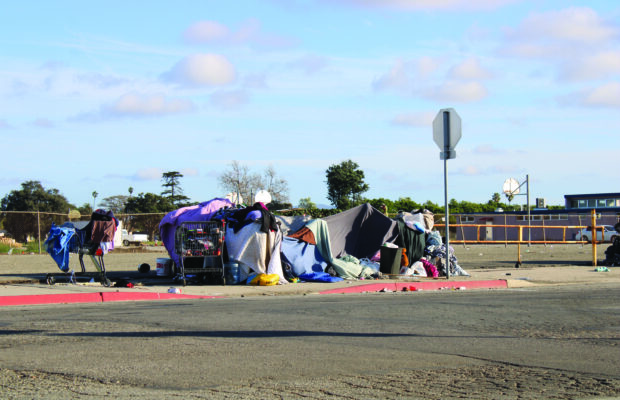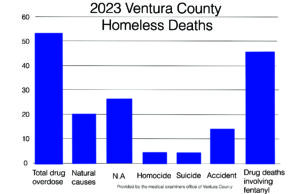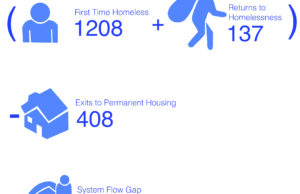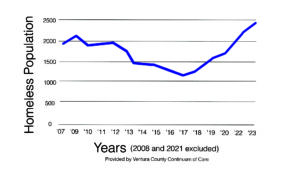HOMELESSNESS SPREADS ACROSS VENTURA COUNTY

Introduction
On a gloomy day in early January, An elderly homeless woman sits smoking a cigarette at the stairwell of the Vagabond Inn Motel in Ventura. Gesturing to chat, she introduced herself as Sharon Dedrick, she had been living at the motel with government assistance for 11 months. Dedrick then led the way to her home [a motel room], barely being able to walk 20 feet to her doorstep, as she explained, “I got the place [The room] because I’m permanently disabled,” Dedrick said.
Dedrick is just one out of the 2,441 homeless individuals who reside in Ventura County, neighbors, brothers, and sisters alike, who share the very same soil that this community calls home. According to The Ventura County Continuum of Care, the County’s homelessness management coordinator, only 1.55% of all homeless people originally resided from outside the county.
Homelessness is a growing humanitarian crisis within the county since there has been an 86% increase in the past six years [2018-2023].
Current local government measures to combat homelessness have led to the results that are seen today prompting the county to draft new plans to win the war plaguing our neighbors into abject poverty. Other Non-profit organizations do their part on the frontlines, by running facilities and working directly with homeless people every day.
Currently
Homelessness has only grown within Ventura County. According to a study on county-wide homelessness conducted by LeSar development consultants in 2023, if the increasing homelessness trends continue the total homeless population will increase to a count of 3,827 people by 2026. The CoC manages the County’s homelessness services, and has taken a new approach to combating homelessness with five major changes in the 2023 Ventura County five-year Homelessness Plan, “We’re not gonna let that happen,” Jennifer Harkey, Program Management Analyst for the Ventura County Continuum of Care, which manages county homeless services [CoC], said.
As Ventura County’s system flow gap is imbalanced due to first time homelessness rising, the CoC is shifting strategies from prioritizing permanent supportive housing, to homeless prevention. The first step in the five-year plan is to establish the [1:4:10 ratio]. Following this strategy, for every one unit of temporary shelter developed, the aim is to develop four units of permanent housing and serve ten households through homelessness prevention. The county can encourage this by allocating received grant funds to prioritize this ratio, “You can get more on the prevention side, and prevent people from becoming homeless; our goal is to start reducing that number,” Harkey said.
The second point of action is the creation of two executive positions within the CoC, a homelessness solutions director, and a housing solutions director. “The whole purpose [of the homelessness solutions director role], would be to work with local jurisdictions, all these different cities, on initiatives and planning and working on what are good best practices for addressing homelessness,” Harkey said. According to the plan, the Housing Solutions Director’s role is to operationalize countywide coordination to address the housing crisis by drafting policy and working with all levels of jurisdiction within the county.
The third point of action is the establishment of a “command center” for a multi-disciplinary team outreach program, tailored to addressing homeless street encampments. The team would be composed of representatives from the Ventura County Healthcare agency, the Sheriffs Office, Human services agency, Behavioral and Public health agencies. Harkey describes the purpose of the team and what it could look like in action, “The idea here is that you have many different partners that can address multiple issues all in one place [making it easier to address issues in real-time],” Harkey said.
The fourth and fifth points of action related to the creation of a comprehensive and real-time database for homelessness and the prioritization of people with lived experiences of homelessness in future decision-making processes.
According to Harkey, “On February 27, we will be at the [Ventura County Board of Supervisors] presenting our recommendations on what we should kind of do with those strategies [listed in the 2023 5-year homeless plan].”

Organizational Failure
Between downtown Ventura and the pier, lies a remnant of the COVID-19 era, The Vagabond Inn Hotel. In early response to the pandemic, Ventura County initiated Project Roomkey, renting out numerous motels and providing vouchers to over 1,051 people prioritizing the medically vulnerable. At the hotel, an anonymous elderly man and alleged resident, referred to as John Brown, revealed, “[staying here] has helped; otherwise I would be at the rescue mission,” Brown said. The transition from the mission to the motel came due to his alleged medical vulnerability, “Because I was unconscious on the toilet seat at the rescue mission, they took me to the hospital; I was there for 15 days.” Brown added, “I have a social worker, a case worker and she got my case and found out that I had been to the hospital, so that’s a prerequisite [to live here],” Brown said. Roomkey, which was designed to limit COVID deaths, prioritizes the medically vulnerable for access to the program. “I’ve been in the hospital tentimes this last year,” Brown said. When contemplating what he would do if the Vagabond Inn’s program ceased he claimed, “I have no place to go, I’ll sleep in my car, I’m one of the fortunate ones because I have a car.” Brown said.
This anonymous man is one of 134 Room-key participants still reliant on the program for housing with each participant costing the county $90 per day. However, county officials are in a race for housing alternatives as a looming total expenditure of $4,315,276, in California Department of Social Services grants finds itself a deadline of March 11th, 2024. Jennifer Harkey, explains that the CoC’s top priority is to fully transition all of the room-key participants by April. Harkey notes the CoC is able to use money from the Housing Homeless and Assistance prevention program [HHAP] to bridge the gap from March 11th until residents are transitioned, although Harkey mentioned that past April the CoC would have to start looking for funds as the $1.5 million dollar HHAP grant will run dry.“ We have a lot of people that are staying in these motels who are going through cancer treatment. they’re on dialysis. They may be diabetes type one and need to have refrigeration for their insulin. I mean, these are vulnerable people who need that shelter and placement,” Harkey said.
Project Home-Key – state of California’s effort to combat homelessness by providing grants to permanent supportive housing projects. The 134 residents are supposed to be transitioned from room-key motels into home-key projects throughout the county; however many of the so-called projects have been delayed due to legal, construction, and financial issues. The Casa Aliento project which was slated to house 69 people, and the Step Up Thousand Oaks Project with 77 units were both due to be completely renovated by December of 2023. Today both projects are construction sites, with the Step Up Thousand Oaks Project accused of being part of an alleged fraud scheme with the owner of the property defaulting on its debts and foreclosing on the property. The La Quinta Inn is a project to support 132 housing units, however, this project also is experiencing delays due to the transferring of grant money from the state. The Project manager of the La Quinta Inn project, now under the name Valentine Road Apartments, Kyler Carlson, from the Housing Authority of The City of San Buenaventura [HACSB], claims that the property’s purchase will be finalized either sometime in February or March of this year. Carlson notes the anticipated dates people will start moving into the apartments, “ Lease ups should start in the middle of the year and we hope to be fully leased by the end of this year. The bulk of the work will be done by September,” Carlson said. None of these projects are expected to be completed by the March 11th deadline.



Personal Experience
A teenager who had experienced homelessness in the past, agreed to speak to the Prowler under the conditions of anonymity, and will be referred to as Jane Doe.
2023 County data suggests over 1,633 people or 67% of the county’s homeless population is unsheltered, 13 of which are children. This leaves the other 33% utilizing other forms of shelter whether that’s government assisted programs, non-profits, living in automobiles, or couch surfing. “Homelessness is a spectrum, right? Not everyone’s homelessness looks the same. Me and my mom really had the best case scenario. There was a home that was open to us from a close friend. But if we didn’t have that, it could’ve been shelters, hotel rooms, It could’ve been maybe on the streets some nights. That’s really horrible to think about, but I’m just really grateful,” Doe said.
The 2020 Census Bureau data noted that 9.1% or approximately 76,790 of the 843,843 residents of the County were living below the poverty level. These people are at extreme risk of becoming homeless, they could become homeless because of increases in rent, loss of job, or rising health care costs. Other personal struggles such as domestic violence, physical disabilities, mental illness, and substance abuse could lead to becoming homeless. Doe speaks to this matter, “People always see homelessness as like, seeing a man on the street… There are so many reasons why someone could lose their home. It could be unsafe, it could be difficulties with family… so many reasons why you just can’t live at your house. Homelessness is so broad. There are so many different types,” Doe said.
In 2022,The Ventura County Office of Education tracked homeless students in all its k-12 public schools. Although the homeless definition differs from the CoC’s, the data shows. “6,638 students temporarily doubled-up or at-risk of homelessness, and 438 of students met the Department of Housing and Urban Development’s definition of homelessness.” Doe shares advice for students facing the struggle of homelessness. “I always tell myself it could’ve been a lot worse. That’s my mindset. I hope other people know that if you can’t stay in your home anymore, try a friend’s house before going to the more extreme options… I am aware of how lucky I was, and when I hear others’ experiences I have a lot of sympathy and empathy,” Doe said.
Actions Needed
With many organizations throughout Ventura County doing what they can to tackle and prevent homelessness, there are also many impactful ways the community can get involved. One non-profit organization that has rapid rehousing services in Ventura County and five others, Mercy House, had representatives speaking to the impact volunteer services provide.
Working in social services may require a degree, but speaking out in local politics does not. Mercy House Human Resources director, Ana Calesti, described the negative effects that the lack of awareness surrounding homelessness in the county results in. “The last city council meetings I went to, they approved a $64 million aquatic center and then denied a homeless shelter a $3 million budget for a year. So there’s a perspective on how the city tends to apply for funding rather than providing shelter as a basic human right for our own community.” Calesti said. “Showing up to city council meetings and helping advocate in that way makes a huge impact. The City Council doesn’t know what the community needs and what things we’re looking for… if you’re not confronted with an issue, then you don’t know what needs to change.”
While the COVID-19 pandemic feels years in the past for most civilians, it hit the homeless population harder than anyone else. Due to the pandemic, homelessness only increased while fears of going into public places decreased the volunteer population. Nina Castellano, the Ventura County Regional Manager for Mercy House stressed the hopes they have to rebuild their program. “I feel like because of the pandemic we’ve had so many like different spurts of having COVID outbreaks that just totaled up the volunteer program…I feel like we haven’t had too much success just yet. But the application is on our website right for individuals. Sign up to become a volunteer for us,” Castellano said.
Beyond attending city council meetings and volunteering, the first step for the community to get involved is to become educated to each homeless individual’s situation. Calesti described the importance of humanity surrounding this topic. “I think there’s a lot of stigma around the homeless population, but I learned more and more every day that it’s really for some people, it’s just one medical condition away or just one paycheck away from ending up on the street. So I think aside from getting involved in local government, just you know, meeting everyone with empathy and understanding,” Calesti said.


